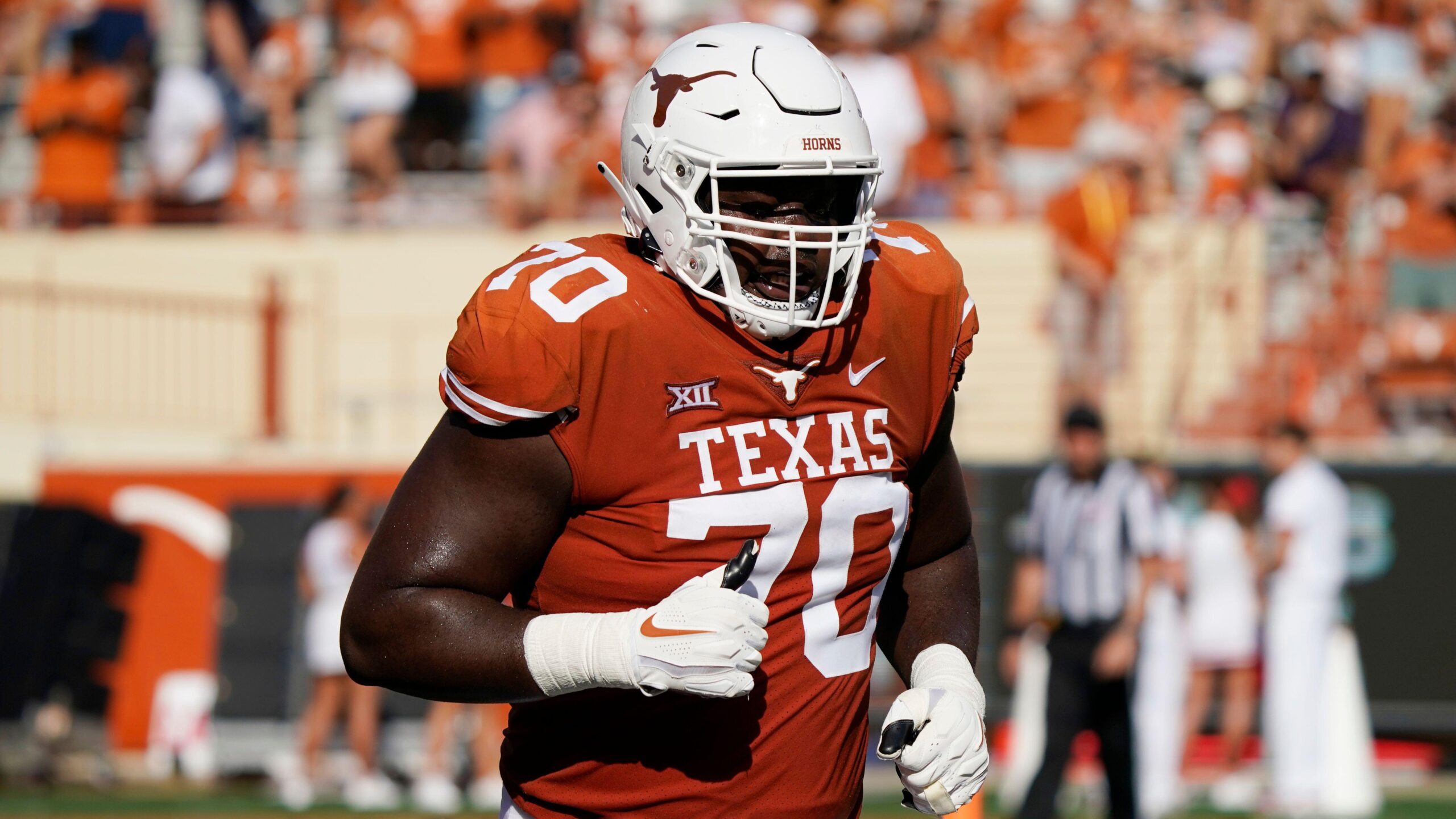The opening of the 2024 NFL Draft in Detroit went exactly as you'd expect. The boos when Roger Goodell walked onto the stage, quickly turned to cheers when Eminem joined him, then back to boos when the commissioner started talking. The crowd kept getting louder, rising to a fever pitch as each successive Lions great came to the microphone. It may be the offseason, but the crowd (the largest in NFL Draft history for the full weekend) was in midseason form.
For the most part, the actual draft went about as expected. To no one's surprise, lots of quarterbacks, wide receivers, and offensive tackles taken in the first round. Also, there were no running backs, safeties, or off-ball linebackers taken. Blame it on no true top-end talent at those positions, large free agent contracts (especially for running backs), or the changing landscape of the game. Whatever the reason, premium picks were spent on premium positions.
One of those premium picks was spent on a premium position (quarterback) at pick number 8. Doesn’t sound too weird, until we pair it with the team and situation. The Falcons won the Kirk Cousins sweepstakes this offseason and signed him to a 4 year, $180 million contract, with $100 million guaranteed. With the QB position all but wrapped up, they could have used pick 8 to draft any number of great players to help the roster for this year and the remainder of the rookie contract. Instead, they drafted Michael Penix Jr, a QB who many think was the 5th best available QB in the draft. This was the one big head-scratching moment in the first round.
The rest of the draft feels like a blur compared to the deliberate pace of the first round. Picks are closer together, the people who get on stage to announce the picks get more and more bizarre, and by the end of the draft, the telecast falls behind in discussing the players who have been picked. Many selections slip through the cracks, and they don’t get the same dedicated screen time. Some even get picked during the commercials. But there are hidden gems picked in the later rounds that will be star NFL players. Using StatsBomb tools, here is a list of a top first-round pick for each position, and then a day 2 or 3 pick that was the most similar.
Quarterback
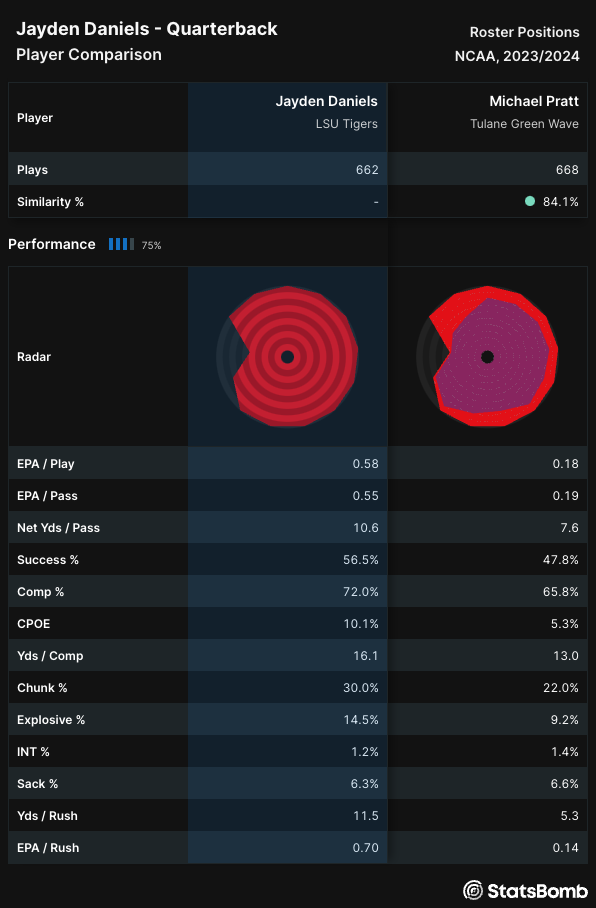
Jayden Daniels was one of the biggest risers up the draft board this season. He didn’t appear on any of the first mock drafts or projections for the 2024 draft, but throughout the seasons his ridiculous stat line saw him shoot up to the number 2 overall pick. Throwing to 2 first round WR’s helps, but what made him stand out from other potential number 2 picks was in the running game. Daniels led the country for QB’s in rushing yards, EPA/rush, yd/rush, and pretty much every other rushing related statistic. He even was 3rd in the country in yds/rush if you throw in running backs. One of the main reasons for his success is his speed. Daniels had 14 plays where he reached over 20 mph according to our tracking data. That type of speed is hard to replicate.
No one is going to confuse Michael Pratt for Jayden Daniels, but as his radar shows above, he had a very similar production profile to Jayden Daniels. The biggest similarity between the two players is the low interception % and low sack %. The rest of the stats for Pratt around the radar are all pretty much in line with, albeit a little lower, than Jayden Daniels. The one big difference is in the run game. As mentioned above, Jayden Daniels was on another level in the run game. Although Pratt didn’t have the same production in the run game, he is capable when he does decide to tuck it and run. He hit over 21 mph on a long scramble last season, and he tested well at the combine also. He has enough athleticism to be able to find success in that area.
Wide Receiver
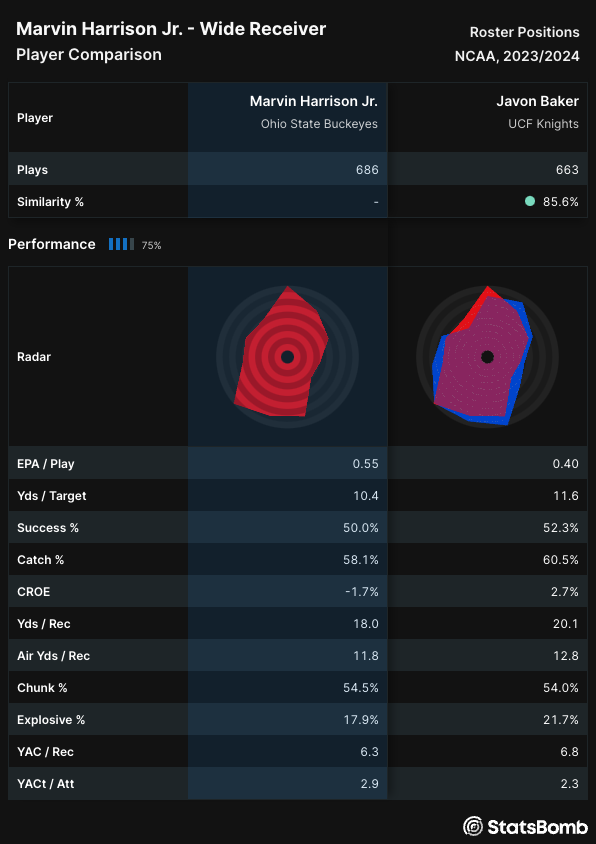
Marvin Harrison Jr has been the projected WR1 in this draft since about midway through his Freshman season. His game has been critiqued and analyzed more than just about any Wide Receiver ever. Even more so when Rome Odunze and Malik Nabers, who could easily be WR1 in any other draft, had such great seasons and crept into the top WR discussion.
To go with his prototypical NFL size, Harrison had the ability to take over a game, the best example being his game against Penn State. He single-handedly helped Ohio State garner just enough offense to eke out a victory:
- 11 catches
- 162 yds
- 1 TD
- .9 EPA/Target
One of the closest comparisons for Harrison Jr last season was Javon Baker from UCF. Taken in the 4th round by the Patriots, Baker was the 18th WR taken off the board. With so many great WRs in the draft, there were going to be some really good players who fell into the later rounds, and Baker fits into that category. Baker was one of the premier deep threats in the country. His 12.8 air yds/reception was slightly higher than Harrison Jr, and only 4 players had more targets with higher air yards. Baker was also similarly skilled after the catch, gaining over 6.5 yards after the catch/reception. With the Patriots drafting Drake Maye, and needing to fill some holes in the WR room, expect Javon Baker to get early opportunities to make some noise.
Tight End
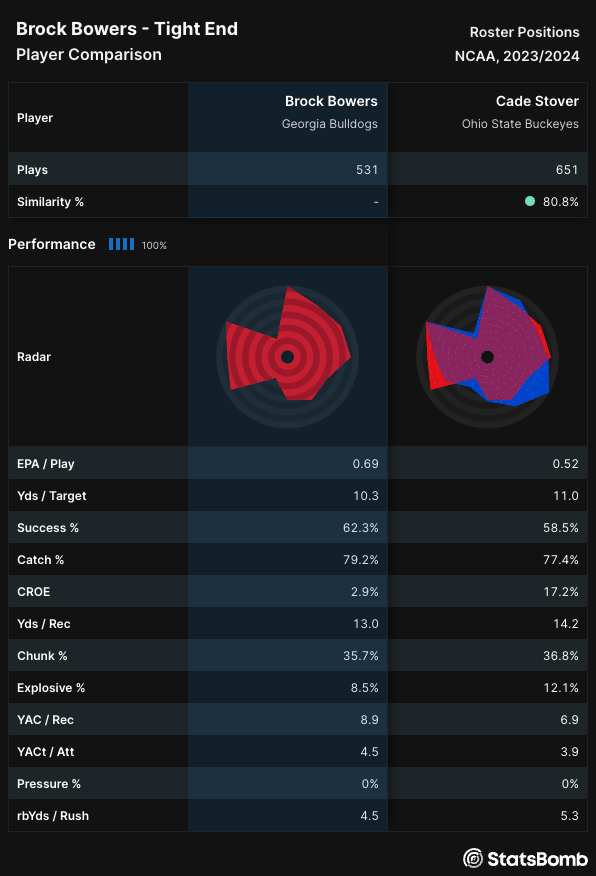
Similar to Marvin Harrison Jr, Brock Bowers has been the presumed TE1 for years. Very few people can do what he can do on a football field. He is an adequate blocker, a great route runner with soft hands, and Georgia even handed him the call on an end around a few times. He was utilized in such a unique way in the Georgia offense, that no one can truly replicate his game.
Cade Stover however, is one of the Tight Ends who, production-wise, was the closest Tight End in comparison to Bowers in this draft. Stover has one of the best receiving maps of any Tight End in the draft (seen below). He had the highest Catch Rate over Expected (CROE) of all Tight Ends (17.2%) in FBS last season. He’s not as shifty once he catches the ball, or as big of a downfield target. But Cade Stover catches the ball well. He is also an effective run blocker, with a 5.3 yards per rush when he is the blocker at the point of attack, .8 yards more than Brock Bowers.

Offensive Tackle
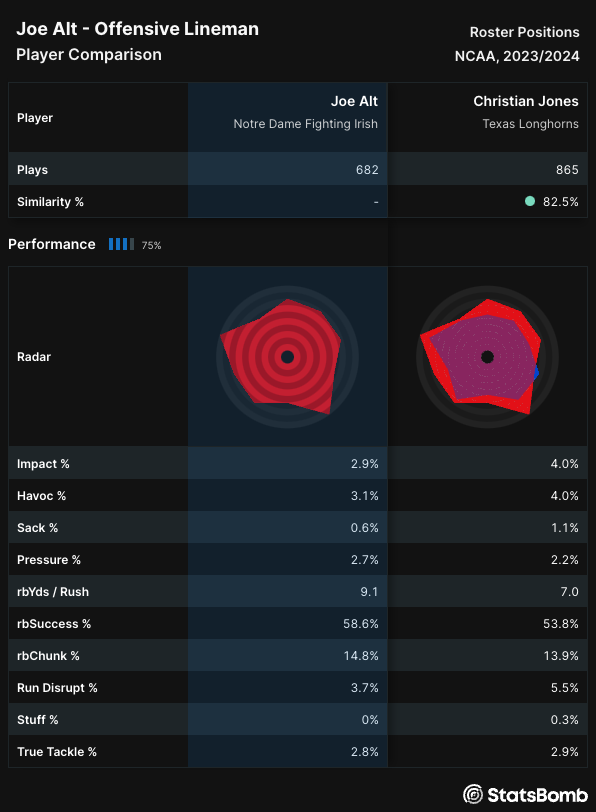
I can’t believe I didn’t start with the Offensive Tackles. I love writing about our OL metrics and often get lost looking at all the cool data we have for them! Joe Alt was the first of NINE(Nine!) offensive lineman taken in the first round. What was it about Joe Alt’s game that Jim Harbaugh fell in love with? If you put 2 and 2 together and thought run game production, you would be right! Joe Alt allowed 0 run stuffs (a tackle at or behind the line of scrimmage) when he was the offensive lineman the run went behind. ND also averaged 9.1 yds/rush when they ran behind him. The guy was moving mass. And these stats don’t take into account his size. At 6’9”, 320 lbs, it’s easy to see why Jim Harbaugh passed on some big time playmakers to pick up the biggest OL in the draft.
The Cardinals (drafters of WR1 Marvin Harrison in round 1) picked up Christan Jones in the 5th round, and with it, one of Joe Alt’s closest comparisons. Looking at the radars, Christian Jones actually was a better pass blocker than Alt, allowing a lower pressure percentage. Though it would be hard to reach Alt’s 9.1 yds/run behind, Texas did average 7 yds/rush running behind Christian Jones. Just like his radar looks like a mini version of Joe Alt, he is also a “mini” Joe Alt at 320 pounds, but only 6’6”. If he were 3 inches taller, would he have snuck his way into an earlier round? Who’s to say.
Defensive Tackle
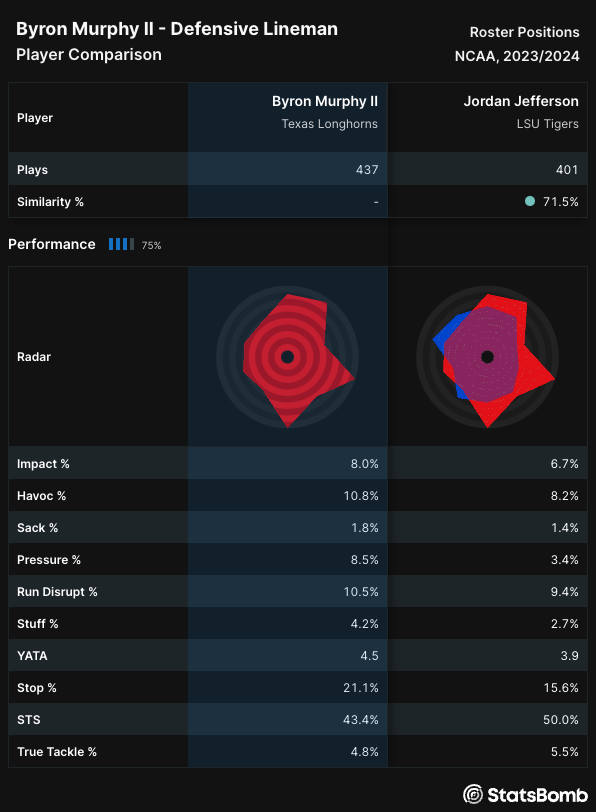
Byron Murphy was the first Defensive Tackle off the board in the first round going #16 overall to the Seattle Seahawks. In 2023, the Seahawks struggled against the run, allowing the 5th most yds/rush. They also allowed the most 20-yard runs in the NFL. Enter Byron Murphy. Murphy was one of the best DTs in the country last year against the run with a 10.5% run disruption rate and a 4.2% stuff rate. Murphy isn’t just a great run defender though, he had an 8.5% pressure rate as well!
Byron Murphy didn’t have many close comparisons that were in the draft this year, but one of the most similar players was Jordan Jefferson (not the QB) out of LSU. As is the case with most later-round draft picks, they are not as well-rounded as early picks. Usually, they have one great trait, and Jefferson’s one true trait to rule them all is run defense. Jefferson had a similar high run disruption rate at 9.4%, and actually was a better tackler than Murphy. He allowed 3.9 yards after tackle attempt, and had a 50% Solo Tackle Success rate (rate at which a defender turns solo tackle attempts into tackles, you get ½ credit if someone joins and makes it an assisted tackle). He also had a higher true tackle percentage. Look for Jefferson to make an impact in the run game for the Jaguars this season.
Edge Defender

Laiatu Latu was one of the most dominant defenders last year in all of college football. He led the FBS in pressures and sacks, and was rewarded as the first defensive player taken in the draft. Latu is especially effective in getting off of blocks, both in the run, and the pass. His comparison radar above is the production radar, while the traits radar is below. When you look at his trait radar, the ALOE’s (Average Length Of Engagement) jump out as noticeable. Over 95th percentile in both Run and Pass ALOE. When you combine that with a great finish to the QB, Latu was a one man wrecking crew for the Bruin defense.
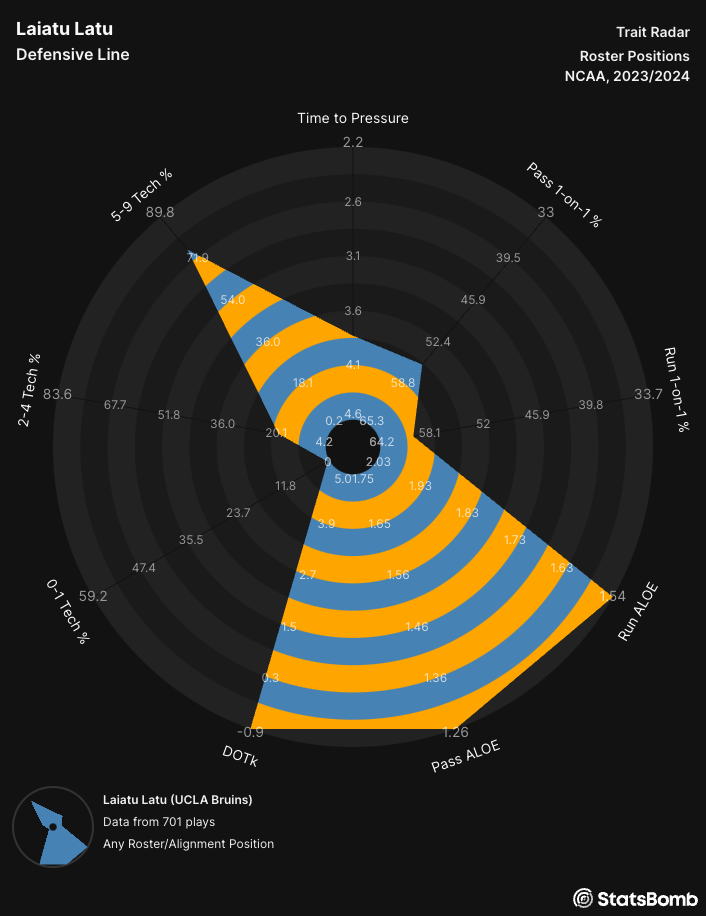
His closest comparison last year was Jonah Elliss out of Utah. In fact, Latu actually passed Elliss late in the season for the nation lead in pressures. Even with missing the final 3 games of the Utes season with injury, Elliss finished tied for 9th in pressures, and 4th in sacks. Elliss didn’t have the same uncanny ability to get off blocks in his pass rush as Latu (see trait radar below), but his motor is what helped him rack up the pressures. Elliss is however a superior run defender to Latu. Almost 1.5 yards better yards after tackle attempt, over 70% solo tackle success rate, and a stop percentage just over 20%. Teams may have been frightened away from Elliss because of his injury, but the Broncos might have gotten one of the best defenders in the draft in round 3.
His closest comparison last year was Jonah Elliss out of Utah. In fact, Latu actually passed Elliss late in the season for the nation lead in pressures. Even with missing the final 3 games of the Utes season with injury, Elliss finished tied for 9th in pressures, and 4th in sacks. Elliss didn’t have the same uncanny ability to get off blocks in his pass rush as Latu (see trait radar below), but his motor is what helped him rack up the pressures. Elliss is however a superior run defender to Latu. Almost 1.5 yards better yards after tackle attempt, over 70% solo tackle success rate, and a stop percentage just over 20%. Teams may have been frightened away from Elliss because of his injury, but the Broncos might have gotten one of the best defenders in the draft in round 3.
Corner
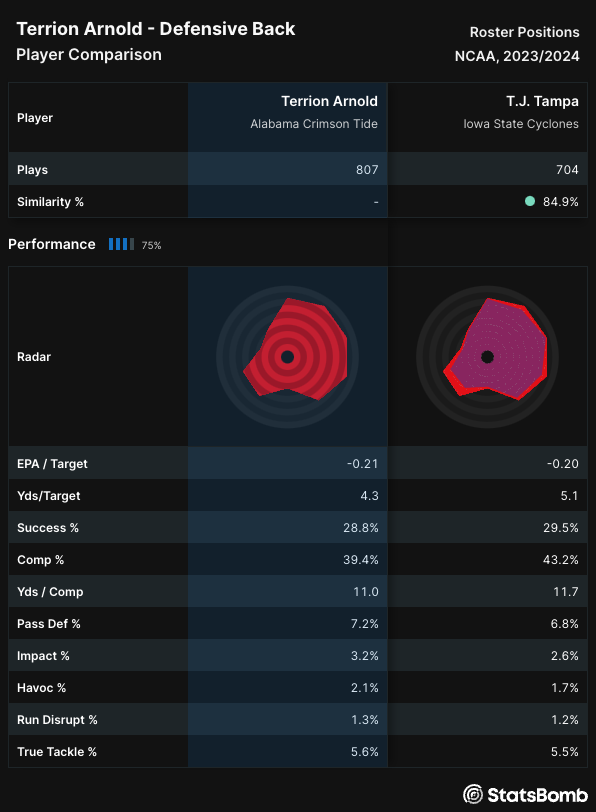
Terrion Arnold was part of the last class (along with Kool-Aid McKinstry and Jaylen Key) from the Nick Saban school of Defensive Backs. While teammate McKinstry liked to press, Terrion preferred playing off. This highlighted his ability to get in and out of breaks when in man to man coverage. Arnold allowed one of the lowest target to completion percentages, and also had 10 contested targets (defender within 1 yard of the receiver at catch attempt), one of the top numbers in the country.
TJ Tampa was one of the closest comps of all the ones discussed so far. As you work your way through the stats from their radars, they are almost identical. -.21 to -.20 epa/target, 28.8% to 29.5% success rate on targeted passes, and 7.2% to 6.8% on passes defended. Tampa had very similar production to Terrion Arnold. One area of difference is that Tampa was asked to press a lot more than Arnold. Tampa is a tall, physical corner, and the Ravens added to their already stacked defense in the 4th round.
Conclusion
There are always big-time NFL starters that were taken later in the draft: Tom Brady, Brock Purdy, Fred Warner, Travis Kelce, and Maxx Crosby and the list could go on and on. The later-round draft picks often go on to be some of the best players in the NFL. Sometimes, it’s all about finding the one skill that someone does really well (Jonah Elliss and rushing the passer) and highlighting it, or about someone who is maybe not size you are looking for in a 1st round player (Christian Jones being 3 inches shorter than Joe Alt) but still is productive. There are a myriad of reasons these players highlighted above weren’t first-round picks. But each of them had similar college careers to the players taken in the first round, and hope to have NFL careers that would compare well to what you would expect from a first round pick.
Matt Edwards
Head of American Football Analysis - StatsBomb
matt.edwards@statsbomb.com
@thecoachedwards on X (Formerly Twitter)

